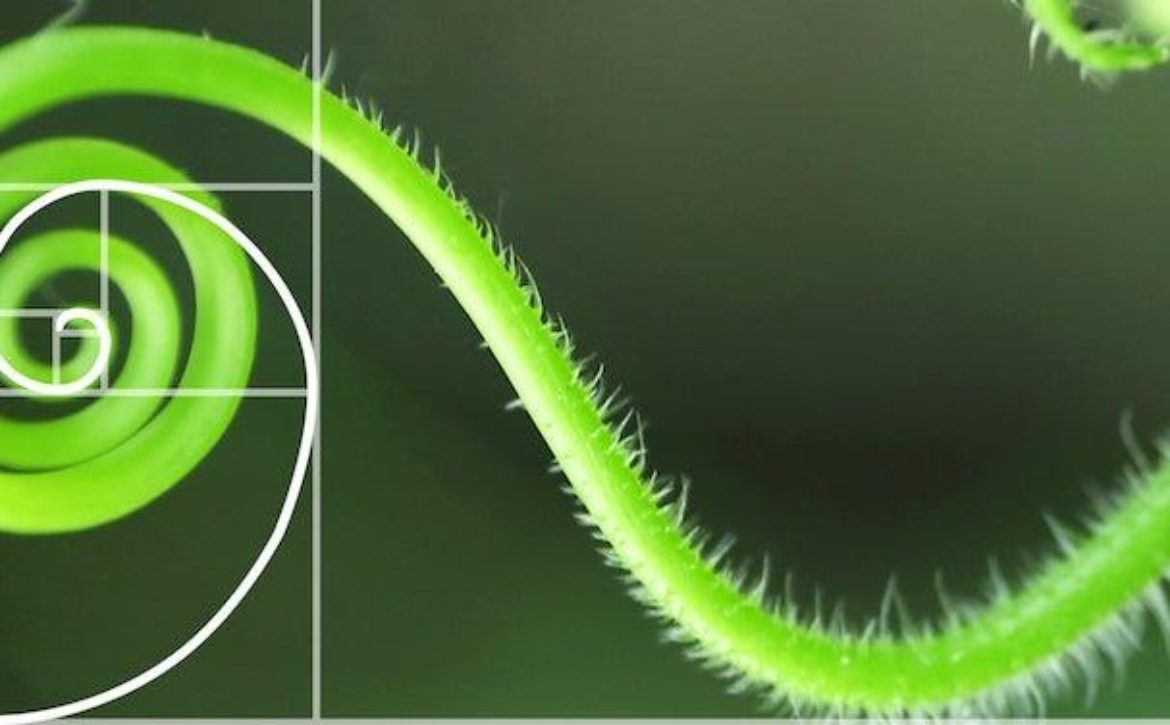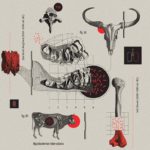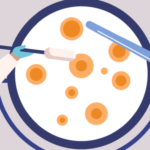
The Math of Living Things – Issue 102: Hidden Truths
It’s hard to argue with the famously authoritative Oxford English Dictionary, but its definition of physics as the “branch of science concerned with the nature and properties of non-living matter and energy” is incomplete because physics studies living things as well. Physicists reported biological research at their first international meeting in 1900, and physics and math still help biologists understand living things.In a striking reverse connection, in the 1940s Albert Einstein and Erwin Schrödinger, founders of relativistic and quantum physics, respectively, projected that tackling questions of biological importance could also enhance physics. They were right: Today researchers are exploring “information” as more than a vaguely defined idea. Instead it has become a specific and unifying concept with deep meaning in both physics and biology.HE WAS RIGHT: Einstein thought biological research could extend physics. “The investigation of the behavior of migratory birds and carrier pigeons may some day lead to the understanding of some physical process which is not yet known,” he wrote.ijARTup / ShutterstockThe first major work to put physics and math into biology came much earlier. The Scottish biologist and polymath D’Arcy Wentworth Thompson published On Growth and Form in 1917, with a massive 1,116 page second edition in 1942.1 It explains that the structure of organisms exists “in conformity with physical and mathematical laws.” Arguing that Darwin’s natural selection is incomplete, Thompson showed how to extend the theory of evolution through analysis. He explained the shapes and sizes of animals and their skeletons through the laws of mechanics, and used pure math to show how an animal’s body might develop. The book influenced scientists with its challenges to Darwinian evolution and its compelling explication of the beauties of the natural world. A recent reconsideration praises it as “provocative and inspiring.”Then in 1944, Schrödinger published a smaller book with a different and profound effect, What is Life?, a record of his public lectures at Trinity College, Dublin, in 1943. Schrödinger’s equation is a cornerstone of quantum theory, and quantum ideas enter as What is Life? responds to a fundamental, then unresolved question: How do organisms preserve and transmit hereditary information through generations?Reasoning from quantum and statistical physics, Schrödinger concluded that genetic data must be carried by a small and durable unit capable of wide variation to account for mutations in biological evolution—a molecule of around 1,000 atoms with different stable quantum configurations that encode the genetic record. After DNA was confirmed as this hereditary molecule, James Watson and Francis Crick found its double helix structure in 1953 (using Rosalind Franklin’s X-ray crystallography data) and credited What is Life? with stimulating their work. The book helped found molecular biology, and also led Schrödinger to glimpse something more. Because of the “difficulty of interpreting life by the ordinary laws of physics,” he wrote, “we must be prepared to find a new type of physical law.” This, he thought, might lie within quantum theory. Einstein and Schrödinger saw that tackling biological questions could enhance physics.
Einstein also thought that biological research could extend physics, starting with investigations by the German-Austrian Nobel Laureate zoologist Karl von Frisch. This work established honeybees as models for animal behavior, and showed that the bees use polarized skylight to orient themselves. In 1949, Einstein noted that this last result did not open new paths in physics because polarization is a well-understood property of light.2 But, he added, “the investigation of the behavior of migratory birds and carrier pigeons may some day lead to the understanding of some physical process which is not yet known.” Clearly he saw the value of a two-way flow between physics and biology.Decades later, the connections seen by Thompson, Schrödinger, and Einstein have grown. One theme in Thompson’s work is the use of pure math to understand the morphology of living things. Thompson explored this by drawing an outline of an organism on a square grid and applying a mathematical transformation such as stretching the grid in one direction. The resulting image resembled another closely related organism—the long body of a parrotfish mathematically became the curved shape of an angelfish. This suggests that an organism’s body develops along preferred directions for cell growth, although math alone does not explain what biochemical and physical processes might cause this.Now new mathematical approaches give deeper views into how organisms develop their bodily structures.In 2020, physicists and biologists at the Technion in Israel analyzed the hydra, a fresh-water animal up to a centimeter long. Its cylindrical body has a foot that adheres to a surface, and a head with tentacles and a mouth that catches and eats prey. This creature interests biologists because a piece of its tissue can regenerate into a complete and functioning new animal. (Hydra are named after a mythological sea monster with many serpent-like heads, with the ability to grow two new heads for every one that was cut off.) Regeneration provides a kind of immortality that may have clues for human lifespans.REGENERATION: Scientists examined hydra, a fresh-water animal up to a centimeter long, under a microscope, and found that as it regenerated, its tissues behaved like atoms in a crystalline solid might.Rattiya Thongdumhyu / ShutterstockThe Technion group microscopically examined a piece of hydra tissue as it regenerated, particularly its multicellular fibers that lie parallel to the long axis of a mature hydra. The tissue first folded itself into a spheroid with its fibers forming a pattern like lines of longitude on Earth, which are parallel near the equator but sharply change orientation as they converge at the North and South poles. This is one type of topological defect, an anomaly that occurs in various forms wherever a regular geometry, like the parallel fibers in a hydra or the atomic arrangement in a crystalline solid, has its order seriously disturbed. It is called “topological” because its understanding and analysis requires topology, the branch of pure math that studies how shapes change when stretched, bent or twisted.The significance of the two topological defects observed in the hydra tissue is that they define its entire body plan because they eventually become the sites of the foot and head in the new cylindrical animal. More work is needed to understand the mechanical and biochemical processes that make topological defects important, but that they mark significant changes in living matter has also just been demonstrated in colonies of bacteria as they grow, in some cases into intricate multicellular structures.Thompson explained the shapes of animals and their skeletons through the law of mechanics.
Another approach Thompson used to great advantage was the physical one of determining how mechanical quantities such as force affect the size and behavior of organisms. He did this by dimensional analysis, which recognizes that any mechanical quantity can be expressed as a combination of the three physical fundamentals mass M, length L, and time T; for instance, velocity has the dimensions L/T, and force the dimensions ML/T2. From these basics, Thompson showed that big fish swim faster than little ones, and that an insect cannot become monstrously huge. This is because as its size increases, its weight increases faster than the strength of its supporting legs, so as it grew it would soon become unable to function.Ken Andersen at the Center for Marine Life, Technical University of Denmark, is now extending dimensional analysis to describe plankton, the enormous group of organisms that is part of the ocean ecosystem. He presented this research at the workshop “On Being the Right Size” organized at Emory University in 2020 to discuss how underlying physical principles determine the size and function of living creatures. (The workshop title comes from a famous 1928 essay by the eminent British biologist J.B.S. Haldane, about the importance of size in setting the capabilities of organisms.)Plankton consists of tiny animals and plants drifting through the oceans. It is important in the Earth’s carbon and oxygen cycles, and in the food chain that produces a significant part of the human diet. To analyze its diversity, Andersen categorized its organisms by how they take in nutrients. For an organism that actively feeds, its rate of ingestion as it encounters food depends on its dimensional speed L/T multiplied by its cross-sectional area L2, or L3/T where L is a characteristic size of the organism. Some animal plankton instead passively absorb nutrients as molecules of dissolved organic matter diffuse into their bodies, which detailed physical analysis shows occurs at a rate L/T. Plants however make their own nutrients by photosynthesis. This requires that they gather solar energy and so depends on the organism’s surface area with the dimensional rate L2/T, along with some nutrition by diffusion at the rate L/T.Andersen plotted these rates of nutrient intake against the size of the organism from 10-4 millimeters to 1 millimeter and found that size correlates with feeding mode. Smaller organisms feed by diffusion, larger ones actively feed, and those mid-range in size tend to be plants that use photosynthesis. The relative numbers of the three types therefore depends on the level of nutrients and sunlight as they occur across the oceans; for instance, with plentiful nutrients but little light, active and diffusion-based animal feeders dominate plants. Andersen is now developing plankton simulator software based on the underlying physical ideas to provide estimates of plankton diversity and function under different ocean conditions.The results for hydra and plankton extend Thompson’s analysis of whole organisms. In showing how atoms carefully arranged in a molecule could carry biological order through generations, Schrödinger’s What is Life? represents a newer approach at the molecular scale. Molecular biology has since led to other advances such as gene editing and better understanding of cellular processes.These successes suggest the attractive possibility of starting from molecules as basic units of biochemical life processes and building up to cells, tissues, organs and whole organisms. Such a reductionist approach seems valid in physics, where in principle elementary particles can be assembled into nuclei and atoms, which then form molecules and bigger assemblies of matter and energy up to the whole universe. Might molecules form the basis of understanding complex living things and perhaps life itself? Perhaps, but some observers think this bottom-up process is insufficient to explain higher-level biological structure and function. A prime example is the difficulty of linking our own internal consciousness, a property of the mind, to the behavior of molecules and neurons in the brain. Perhaps a different idea is needed to make the jump from molecules to complete living things.The tissue folded itself into a spheroid with its fibers forming a pattern like lines of longitude on Earth. Schrödinger thought so when he speculated that to understand life, known physics should be supplemented by a “new type of physical law” that might come from quantum theory. Researchers have since reported some signs of quantum behavior or theorized about it in such areas as photosynthesis and olfactory response. But these results are controversial, and a convincing case for the widespread biological influence of quantum effects remains to be made.There is however a broad physical law that was not widely appreciated in Schrödinger’s time but is now important in physics and biology. In 1867, the Scottish mathematical physicist James Clerk Maxwell imagined a so-called “Maxwell’s demon.” This tiny being would reside in a box of gas and sort its fast and slow molecules into separate chambers. Temperature correlates with speed, so the result would be a temperature difference between the hot and cold regions that could produce useful work. In thus showing how to produce energy from pure information, Maxwell’s demon gave information physical reality. Then in the 1940s the mathematician Claude Shannon showed that the information describing a given system reflects the degree of order in the system. Thermodynamics describes order in a different way, through the quantity called entropy; Shannon’s insight gave further physical weight to information by linking it to order, entropy, and thermodynamics.Relating information to order and thermodynamics has special meaning in living organisms, which survive, grow and reproduce by maintaining their internal organization. This is implicit in the so-called “central dogma” of molecular biology, the statement by Francis Crick that the information stored in the DNA molecule flows to other molecular processes that make proteins and then a whole organism according to plan. Following the flow of information is therefore a way to describe the thermodynamics of entire biological systems. This opens up the study of properties that arise when the interactions among the system’s components, such as the neurons in the brain, produce new “emergent” high-level behavior.This more expansive approach is influencing research at the interface of physics and biology as shown at a 2018 symposium held at Trinity College to celebrate the 75th anniversary of the lectures that became What is Life? The event featured noted scientists who projected where research in new areas related to information and emergent properties, such as complex systems and the network of neurons that constitutes the brain, will take both physics and biology in years to come. Whatever those outcomes, what is surely important is the growing use of a broad approach based on information, which encompasses physical and biological science. Only such a powerful multidisciplinary, even transdisciplinary effort could hope to finally answer Schrödinger’s original question: What is life?Sidney Perkowitz is the Candler Professor of Physics Emeritus, Emory University. His latest books are Physics: A Very Short Introduction, Real Scientist Don’t Wear Ties, and Science Sketches (forthcoming).References1. Thompson, D.W. On Growth and Form: The Complete Revised Edition Dover, Mineola, NY (1992).2. Dyer, A.G., et al. Einstein, von Frisch and the honeybee: a historical letter comes to light. Journal of Comparative Physiology A (2021).3. Schrödinger at 75—The Future of Biology, Trinity College Dublin, https://www.tcd.ie/biosciences/whatislife/Lead image: Africa Studio / ShutterstockRead More…
Read More


